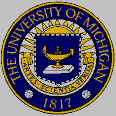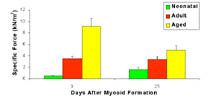
Research on Aging Muscle
Robert G. Dennis, Ph.D.

 |
Research on Aging Muscle Robert G. Dennis, Ph.D. |
 |
I have a very strong interest in studying the plasticity of aged muscle, and it's capacity to regenerate. The clinical applications of functional tissue engineering will certainly involve the re-engineering of tissue from aged humans.
In a series of experiments with my colleague
Paul Kosnik, Ph.D., we have determined that muscle from aged animals (rats),
even from the oldest-old age group (36 months old), can be re-engineered
into functional skeletal muscle in vitro. Most surprisingly,
we found that the contractility of muscle engineered from aged rat tissue
was superior to that of muscle engineered from adult or neonatal tissue.
This result is highly counter intuitive, since the proliferative capacity
of neonatal tissues is generally much greater than that of adult tissues,
and correspondingly it is generally expected that the tissue yield and
function of cultured neonatal cells will be superior. We hypothesize
that the superior contractility of engineered muscle tissue from the aged
rats results from a 'memory of phenotype' in the satellite cells from the
aged animals. There is some evidence throughout the muscle tissue
cell culture literature that satellite cells in culture will preferentially
express the myosin isoform of the muscle fiber with which it was associated
before the cells were isolated and cultured. That is, satellite cells
associated with slow-twitch fibers will tend to express more of the slow
isoform of myosin when cultured, whereas those associated with fast twitch
muscle will express more of the fast isoform. We hypothesize that
this memory effect is greater in older tissues, and thus tissues from older
animals will more strongly express adult isoforms when cultured.
| In the bar graph to the right, the specific force (Pa) is shown for skeletal muscle engineered myooids from neonatal, adult, and old rats (text colors correspond to the bars). The contractility was measured 3 days (left) and 4 weeks (right) after formation of the myooids. In both cases, the contractility of the muscle from the aged rats was superior to that of the muscle tissue from either neonates or adults. |  |
Bob's Home Page Current Research Muscle Mechanics Lab (U of M) Biomechatronics Group @ MIT